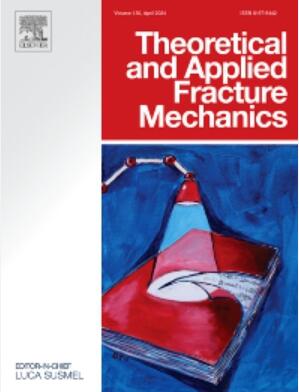不同缺陷特征砂岩在三轴应力下的力学和超声波特性研究
IF 5
2区 工程技术
Q1 ENGINEERING, MECHANICAL
引用次数: 0
摘要
本研究探讨了三轴应力下缺陷角度和长度对砂岩力学性能和超声波速度的影响。不同缺陷角度(0°、30°、60°、90°)和不同缺陷长度(10 mm、15 mm、20 mm、25 mm)的砂岩试样通过常规三轴压缩试验和超声波监测系统进行了全面检测。实验结果表明,缺陷角度和长度对砂岩的机械性能和超声波速度有显著影响。随着缺陷角度的增加,砂岩的峰值应力和弹性模量都呈上升趋势。相反,缺陷长度的增加会降低砂岩的机械强度和结构完整性。尤其值得注意的是,当缺陷长度超过 20 毫米时,裂纹的不稳定扩展会明显加剧,导致砂岩在较低应力水平下断裂。纵波波速的变化反映了砂岩的破坏过程和裂纹演变特征。波速最初呈暂时性上升,随后持续下降,转折点出现在裂缝闭合应力附近。与此相反,裂缝宽度的演变规律却与之相反。这项研究为了解缺陷特征对砂岩力学和超声波特性的影响提供了新的见解,为地质工程设计、岩石稳定性评估和煤矿开采作业提供了宝贵的指导。本文章由计算机程序翻译,如有差异,请以英文原文为准。
Investigation of mechanical and ultrasonic properties of sandstone with different flaws characteristics under triaxial stress
This study investigates the impact of flaw angle and length on the mechanical properties and ultrasonic wave velocity of sandstone under triaxial stress. Sandstone specimens with different flaw angles (0°, 30°, 60°, 90°) and varying flaw lengths (10 mm, 15 mm, 20 mm, 25 mm) underwent comprehensive examination through conventional triaxial compression tests and ultrasonic monitoring systems. The experimental results indicate that flaw angle and length significantly affect the sandstone’s mechanical properties and ultrasonic velocity. As the flaw angle increases, both the peak stress and elastic modulus of sandstone demonstrate an upward trend. Conversely, increasing flaw length diminishes the sandstone’s mechanical strength and structural integrity. Particularly noteworthy is the observation that when the flaw length exceeds 20 mm, the unstable expansion of cracks significantly escalates, resulting in sandstone fracture at lower stress levels. The variation of longitudinal wave velocity reflected the failure process and crack evolution characteristics of sandstone. The wave velocity initially shows a temporary increase followed by a continuous decrease, with the turning point occurring near the crack closure stress. In contrast, the evolution of crack width is observed to follow the opposite pattern. This study provides new insights into the impact of flaw characteristics on the mechanical and ultrasonic properties of sandstone, offering valuable guidance for geological engineering design, rock stability assessment, and coal mining operations.
求助全文
通过发布文献求助,成功后即可免费获取论文全文。
去求助
来源期刊

Theoretical and Applied Fracture Mechanics
工程技术-工程:机械
CiteScore
8.40
自引率
18.90%
发文量
435
审稿时长
37 days
期刊介绍:
Theoretical and Applied Fracture Mechanics'' aims & scopes have been re-designed to cover both the theoretical, applied, and numerical aspects associated with those cracking related phenomena taking place, at a micro-, meso-, and macroscopic level, in materials/components/structures of any kind.
The journal aims to cover the cracking/mechanical behaviour of materials/components/structures in those situations involving both time-independent and time-dependent system of external forces/moments (such as, for instance, quasi-static, impulsive, impact, blasting, creep, contact, and fatigue loading). Since, under the above circumstances, the mechanical behaviour of cracked materials/components/structures is also affected by the environmental conditions, the journal would consider also those theoretical/experimental research works investigating the effect of external variables such as, for instance, the effect of corrosive environments as well as of high/low-temperature.
 求助内容:
求助内容: 应助结果提醒方式:
应助结果提醒方式:


